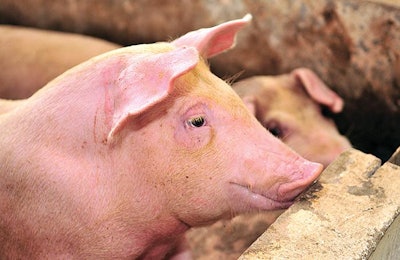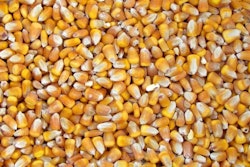
The swine influenza virus affects pigs with clear clinical signs in acute outbreaks. It also has an impact on herd productivity when the disease becomes endemic. Vaccination, together with husbandry and biosecurity, are the main control strategies to keep our pigs protected, although immunization does not always mean protection.
The double-trouble of influenza in swine
Swine influenza is caused by an influenza type A virus (IAV) (family Orthomixoviridae). When the virus enters the herd, there is a rapid onset of disease with clinical signs of high fever, anorexia and lethargy, and respiratory symptoms, such as abdominal breathing and coughing, which affect a large number of pigs (high morbidity). The mortality is usually low.
Read more: 6 most common pig diseases worldwide
The IAV is also important from a human health perspective. Swine can act as source of human flu as was demonstrated in the pandemic outbreak that occurred in 2009 with the strain pH1N1. In addition, avian and human influenza are able to infect pigs; as a result, new variants resulting from the recombination human-porcine-avian influeza can threaten the human population. Both animal disease and zoonotic risk make the swine influenza a pathogen of paramount importance for farmers. It is important to discuss the impact of the infection in our herds and the current usefulness of vaccination to control the virus in our farms.
The impact of the infection within the herd
Swine influenza is defined as an infection with a rapid onset, high morbidity and clear clinical signs. That situation occurs when the virus affects the herd for the first time or when a complete new pathotype is spread into the herd. However, once the virus is established in the herd, the disease can turn into an endemic, subclinical form, with vague respiratory signs that usually are attributed to other respiratory disorders occurring on the farm (pleuropneumonia, porcine respiratory and reproductive syndrome, etc.). The endemic form of the disease, although not clinically visible, clearly impacts the growth of these animals and even can affect sow productivity (there are documented cases of abortions and acyclic heat repetitions at service).
Animal disease and zoonotic risk make the swine influenza a pathogen of paramount importance for farmers.
So, the question that arises is: What is the impact of the infection within the herd? That is probably not an easy question to answer, as other pathogens different from influenza may be present and also negatively affect the productivity of the herd. By comparing infected versus non-infected pigs from the same batch, we overcome the problem stated before and are able to obtain a good estimation of the impact of the virus in the production as well as the cost of the endemic form of swine influenza.
Although literature about estimation of cost caused by swine influenza is scarce, here we provide a few examples extracted from the scientific literature. For instance, Er and colleagues in Norway (2016) estimated that pigs from infected batches required between 5.13 and 9.8 kg of extra-feed during the fattening period (33 to 100kg). In the same study, it was demonstrated that the negative impact of the infection varied depending on the moment of its onset (weaning, growing or finishing), with higher losses in pigs infected in the last part of the fattening period (80-100 kg) compared to earlier infected animals. Another study, carried out in a Spanish herd with 800 sows, failed to find differences in feed parameters, although the mean time to reach market weight was increased in 2.6 days per pig while mortality increased by 0.87 percent in infected batches. By these two negative aspects, the cost of the infection in that particular farm was estimated at $0.716 per pig. If we consider additional cost associated to medication and occurrence of secondary pathologies (such as enzootic pneumonia or Glasser’s disease), these cost could be easily being increased.
Vaccination: Does it solve the problem?
The main solution to control the IAV is vaccination, but is it efficient in protecting pigs? Complete protection or long-term protection is challenging if we consider the ability of the virus to mutate and evade the immune response elicited by the vaccine used. Thus, realistic goals of the vaccination should target the proper stimulation of the immune system to reduce clinical signs and virus replication, limiting its impact in the host and the spreading within the herd. Effectiveness of vaccines will depend on the virus strain circulating on the farm, the type of vaccine used (killed, attenuated or sub-units), the vaccination program and other husbandry factors.
The first two are undoubtedly the most important. Killed and sub-unit vaccines are only useful providing homologous protection and do not work against variants different from the virus used in the vaccine. Subunits and live-attenuated/recombined vaccines, although less common in the market, are more useful and will replace the first in the next future. Vaccination programs should include the vaccination of breeders, proper immunization of the replacement gilts (previous checking these are not already infected by IAV) and the vaccination of weaned pigs if the dynamic of the infection demonstrates that piglets become viremic at early weaning. At the same time, in multi-site production herds, it is of paramount importance to characterize the status of the different origins and provide sufficient protection to naïve/susceptible pigs.
A challenge, and an important one
Swine influenza is an important disease due to its success infecting herds and being widespread all over the world, causing production losses not only in the acute form but also when it is established endemically in the herd. It is one of the principal zoonosis that pigs can transmit to humans. The detection, characterization and control of the virus in our herds is thus of importance, and the development of useful vaccines is not only a challenge but a must as well.

















